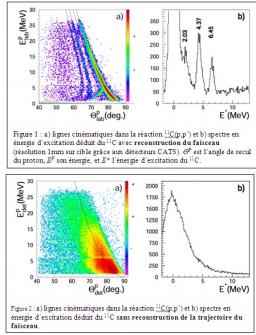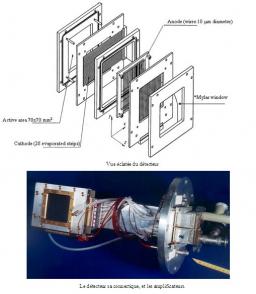Project context
The BTD project was developed in the framework of experiments aiming at the spectroscopy studies of radioactive nuclei using gamma-radiation and light particles in GANIL, mainly with SPIRAL and then SPIRAL2 beams. The purpose of these experiments is to study the structure of exotic nuclei in order to better understand the interactions that bind protons and neutrons and their reactions to different excitation modes (temperature, spin...). In particular, the isospin variable (number of neutrons relative to number of protons) in exotic nuclei can take large values compared to their stable isotope(s). This has made it possible to highlight new surprising nuclei behaviors, such as the phenomenon of neutron halo (very large spatial extension of neutrons), or nucleon clusters.
These beam detectors are part of a set of detectors designed to study exotic beams. They are intended to work in conjunction with other types of detectors such as:
- EXOGAM for the detection of gamma-rays,
- MUST, MUST2 for the detection of light particles around the interaction target
- VAMOS as a high acceptance spectrometer, for the detection and identification of low energy heavy ions.
In the longer term, the AGATA (for gamma-ray measurements) and GRAPA (for particle detection) projects are developments of this type of instrumentation for the accelerators of the future (EURISOL, GSI).
It should be noted that Irfu has been strongly involved in the development of these various instruments.
Experiences of direct reactions
Direct reactions are an adequate method of studying radioactive nuclei. Direct reaction here refers to a reaction between two nuclei that is sufficiently brief that knowledge of the kinematics of the particles (their energy and direction) before and after the reaction can provide direct information about the reaction itself. These measurements make it possible to reconstruct the angular distributions of the effective reaction sections and the excitation energy spectra of the studied nuclei that give information on the structure, as well as on the reaction modes themselves.
The elastic or inelastic scattering of the projectile on a target or the transfer of a certain number of nucleons between the target and the projectile are direct reactions.
The variables of interest for these reactions are (see Figure 2):
- the masses and atomic numbers of the different ions after reaction,
- their respective energies (Ed, Ep),
- the angles of the scattered ions (Qd, Qp)
Angles, masses and energies are linked by known kinematic relationships.
The mass identification and charging of ions is ensured by detectors placed around or after the target. For example, MUST2 measures the energy and flight time of light particles (Z<6) to identify them. The VAMOS spectrometer measures ion energy and energy loss in an ionization chamber to identify heavier ions. Ion energy measurements are also supported by these detectors.
The measurement of scattering angles requires taking into account the characteristics of the beam ions. Indeed, beams of exotic nuclei have a large emittance which is due to their mode of production. Not only is their angular aperture large (a few degrees), but their spatial extension on the target is not negligible in terms of measurement accuracy. They sometimes extend over several square centimeters. It is therefore essential to know the trajectory of each ion in the beam and its point of impact on the target. To do this, it is sufficient to reconstruct at two points upstream of the beam the passage positions of each ion in the beam. Figures 3 and 4 show the kinematic lines reconstructed using two CATS detectors for a scattering reaction of an 11C beam on a proton target. Figure a) shows the result with a reconstruction of the trajectories of the beam ions, figure b) without this reconstruction. The clear lines shown in Figure 3 are completely blurred by the emittance of the beam in Figure 4.
Finally, it is important that beam detectors can give a fast signal, which allows the ion time of flight to be accurately determined. This signal can also be used as a time reference and trigger for detection to normalize the data collected against the incident ion flow.
Specifications.
For direct reaction measurements, the reconstruction of the beam ion trajectory is performed at GANIL using two CATS detectors (Saclay Trajectory Chambers) placed upstream of the reaction target. These detectors provide a 2D ion position measurement and a fast time signal. While they work well (see Figure 3), they have a number of limitations:
- a too low counting rate, due to the slow reading of the signals on the 2 x 28 tracks that make up the detector but also to the resistance of the detector against intensities higher than some 10000pps. The cathodes suffer significant damage to these flows.
- a deterioration in the time resolution and efficiency of the detector for light ions (1.7ns and 83% efficiency for 8He to 15.6MeV/n).
Taking into account the evolutions of the detectors, in particular MUST2 and EXOGAM, the characteristics of a suitable beam detector have been defined with the following specifications:
- the ability to resist heavy ion flows of about 105 particles per second,
- a reduced electronic dead time, less than 50s (dead time of the MUST2 detector),
- a two-dimensional spatial resolution of 0.5mm (to allow a target resolution of about 1 mm),
- a time resolution of less than one nanosecond,
- an efficiency of more than 90%, especially for light ions.
Detector mechanics
The CATS detector (Saclay Trajectory Chambers) is a multi-wire proportional detector. It is composed of an aluminum frame holding the different layers:
-two 1.5µm Mylar windows that confine the gas
-two 0.9µm Mylar sheets which constitute two symmetrical cathodes. They are covered with aluminized tracks with an orthogonal pitch of 2.54 mm and whose load can be read independently.
-A median wire plane that constitutes the anode. A positive high voltage is applied (~700V). It measures a fast signal that serves as a time measurement.
The transparency of the detector is one of its assets.
How it works
A large field (780V/3mm) is created between the central electrode and the side tracks. This field is uniform in the area far from the cathode, and with a high gradient in the anode area (wire with a small bending radius). These two zones determine two steps in the operation. Between the cathode and the proximity of the anode, the electric field is considered constant, which corresponds to a so-called parallel plate area. In this zone, the electrons produced are moved by the field towards the anode, and are multiplied by avalanche. The displacement of these loads induces a fast signal (time signal) taken from the anode.





